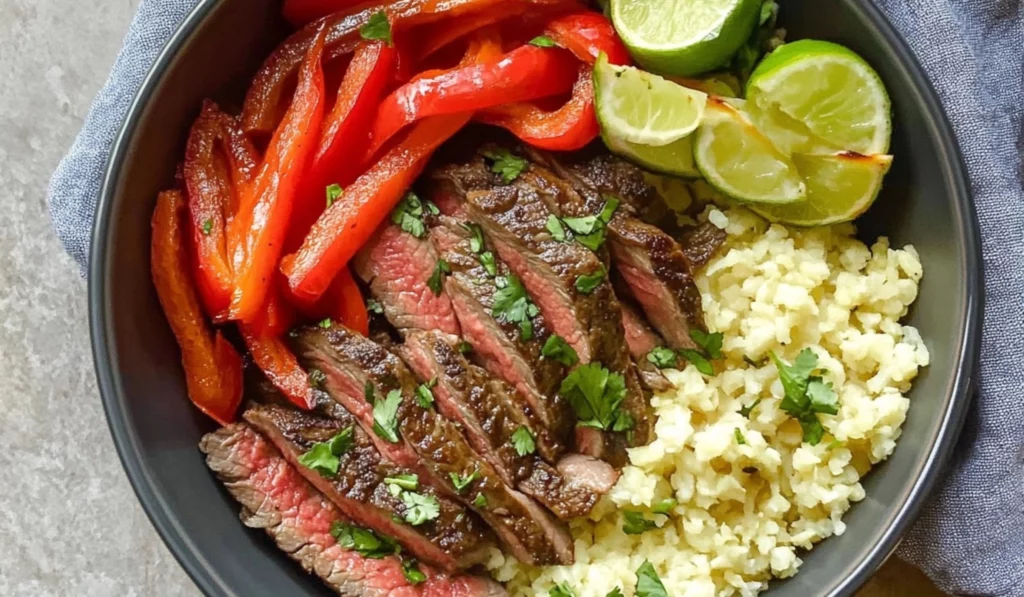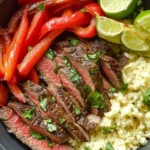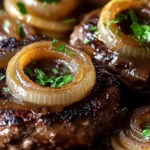I’ll never forget my first steak fajita. It was at a small, family-owned Mexican restaurant, tucked away in a quiet corner of the city. The sizzling platter of steak, peppers, and onions arrived at the table, carried by a friendly server, filling the air with an irresistible aroma – a mix of smoky spices, caramelized onions, and perfectly seared steak. The combination of tender, flavorful steak and vibrant, slightly charred veggies was simply divine. I was hooked! But traditional fajitas, with their flour tortillas, while delicious, can be a bit carb-heavy, especially if you’re watching your carbohydrate intake or trying to eat a bit healthier. That’s what inspired me to create this High Protein Steak Fajita Bowl – all the mouthwatering fajita flavor, but in a healthier, low-carb, and incredibly convenient package. This recipe is a beginner cook’s dream. It’s incredibly simple, takes minimal time (ready in under 30 minutes, plus marinating time, which can be done while you’re at work or running errands!), and is packed with protein and essential nutrients, making it a guilt-free and incredibly satisfying meal that’s perfect for any day of the week. If you’re looking for a quick and healthy weeknight dinner that’s bursting with flavor, a flavorful and portable lunch to take to work, or just a delicious and satisfying way to enjoy a perfectly cooked steak, this High Protein Steak Fajita Bowl is your perfect solution. It’s a fiesta of vibrant flavors and textures in a bowl!

High Protein Steak Fajita Bowl: A Flavor Fiesta in a Bowl
Craving a delicious and satisfying meal that’s also good for you? This High Protein Steak Fajita Bowl is the perfect solution! Tender, marinated steak, vibrant roasted veggies, and flavorful cauliflower rice come together in a bowl of pure deliciousness. It’s a quick, easy, and healthy meal that’s perfect for any occasion. This easy recipe is ideal for beginner cooks, requiring minimal effort and delivering maximum flavor.
- Prep Time: 15 minutes
- Cook Time: 35 minutes
- Total Time: 50 minutes (plus marinating time)
- Yield: 3 servings 1x
- Category: Dinner, Lunch
- Method: Roasting, Sautéing, Pan-Frying
- Cuisine: Mexican, Tex-Mex
- Diet: Gluten Free
Ingredients
- Steak:
- 1 lb skirt steak
- 2 tbsp chipotle peppers in adobo sauce
- 2 tbsp avocado oil
- 2 tbsp lime juice
- 1 ½ tsp cumin
- Salt and pepper
- Veggies:
- 1 red bell pepper, sliced
- ½ yellow onion, sliced
- ½ tbsp avocado oil
- ½ tsp cumin
- Salt and pepper
- Cauliflower Rice:
- 1 10-oz bag riced cauliflower
- ½ tbsp avocado oil
- Salt and pepper
Instructions
-
Marinate the Steak: The Flavor Infusion Begins: In a bowl or shallow dish (a resealable plastic bag works great too!), combine the marinade ingredients (chipotle peppers, adobo sauce, oil, lime juice, cumin, salt, and pepper) and stir or whisk well until everything is thoroughly mixed. Add the skirt steak, toss to coat it evenly with the marinade, and marinate for at least a few hours, or preferably overnight (this is where the real flavor magic happens!). The longer it marinates, the more flavorful and tender the steak will become. Pro Tip: Marinating the steak for longer will result in a more intensely flavored and incredibly tender steak. If you’re short on time, even a 30-minute marinade will add some flavor. Remove the steak from the refrigerator about 30 minutes before cooking to bring it to room temperature. This will help it cook more evenly and prevent it from becoming tough.
-
Roast the Veggies: The Sweet and Smoky Transformation: Preheat your oven to 400°F (200°C). Slice the bell pepper and onion into strips (about ¼-inch thick) and place them on a baking sheet lined with parchment paper for easy cleanup. Drizzle the vegetables with ½ tablespoon of olive oil and sprinkle them with salt, pepper, and ½ teaspoon of cumin. Toss to coat the veggies evenly, ensuring that each piece is coated with oil and spices. Roast the pepper and onion strips in the preheated oven for 15 to 20 minutes, or until they are tender, slightly caramelized, and have a beautiful char. Pro Tip: Roasting the vegetables brings out their natural sweetness and adds a delicious smoky char. You can also grill or sauté the vegetables if you prefer. Keep an eye on the vegetables while they’re roasting and toss them halfway through to ensure even cooking.
-
Cook the Cauliflower Rice: The Healthy and Flavorful Base: While the veggies are roasting in the oven, heat ½ tablespoon of avocado or olive oil over medium heat in a large skillet (a wok works well too). Add the riced cauliflower (either store-bought or homemade) and stir regularly until it turns slightly golden brown and tender, about 15 minutes. Season the cauliflower rice with salt and pepper to taste. Pro Tip: Cooking the cauliflower rice over medium heat will prevent it from burning and allow it to steam and soften. You can also add other seasonings to the cauliflower rice, such as garlic powder, onion powder, chili powder, or even a squeeze of lime juice for extra flavor. Once cooked, place the cauliflower rice in a bowl and cover it to keep it warm while you cook the steak.
-
Cook the Steak: The Star of the Show: Shake off any excess marinade from the steak (don’t discard the marinade – you can use it to make a quick pan sauce later if you like). In the same skillet (or a clean skillet) over medium-high heat, add a tablespoon of avocado oil. When the oil is hot and shimmering, add the steak to the skillet. Cook the steak for 2 to 3 minutes per side (depending on the thickness), until it reaches medium-rare (130 degrees F) or your preferred doneness. Pro Tip: Use a meat thermometer to check the internal temperature of the steak for accurate doneness. Medium-rare is the recommended doneness for skirt steak, as it is tender and juicy at this temperature. Overcooking it will make it tough and chewy. Sear the steak quickly to lock in the juices and create a nice crust.
-
Rest and Slice: The Juiciness Secret: When the steak is cooked to your liking, remove it from the skillet and place it on a cutting board. Let the steak rest for at least 5 minutes before slicing it. Resting the steak is crucial, as it allows the juices to redistribute throughout the meat, resulting in a more tender, flavorful, and juicy steak. Pro Tip: Don’t skip the resting period! It makes a huge difference in the final texture and flavor of the steak.
-
Slice and Assemble: The Bowl’s Creation: Once the steak has rested, slice it against the grain into thin strips. This will make it even more tender and easier to eat. To assemble the bowls, evenly spoon the cooked cauliflower rice into three bowls. Top the cauliflower rice with the roasted vegetables (bell peppers and onions) and the sliced steak.
Notes
- Marinate steak for maximum flavor.
- Use a meat thermometer for perfect steak doneness.
- Customize veggies to your liking.
- Add your favorite toppings like salsa or guacamole.
Ingredients and Preparation: Your Flavorful Toolkit – The Building Blocks of Deliciousness
This High Protein Steak Fajita Bowl is wonderfully adaptable. Feel free to adjust it to your preferences, dietary needs, or what you happen to have on hand in your refrigerator and pantry. Remember, the key to stress-free and successful cooking is mise en place – having all your ingredients prepped, measured, and ready to go before you even turn on the stove. This simple step will make your cooking experience so much smoother, more enjoyable, and ultimately more successful.
The Steak Marinade: The Flavor Infusion – The Key to Tender and Tasty Steak:
- 1 pound skirt steak – Alternatives: Flank steak, hanger steak, or even ribeye (for a more premium option) can be used. Skirt steak is known for its intense beefy flavor and tender texture, making it absolutely perfect for fajitas. It also cooks quickly, which is ideal for this recipe.
- 2 tablespoons chipotle peppers in adobo sauce (finely chopped) with sauce – Alternatives: You can use chipotle powder, smoked paprika, or even a pre-made fajita seasoning blend (just be mindful of the sodium content). Chipotle peppers add a smoky and spicy flavor that is essential to the authentic fajita experience. The adobo sauce itself adds a depth of flavor and a touch of sweetness.
- 2 tablespoons avocado or olive oil – Alternatives: Any neutral oil with a high smoke point (like grapeseed, canola, or even peanut oil) can be used. Oil helps to tenderize the steak, prevents it from sticking to the pan during cooking, and helps the marinade penetrate the meat.
- 2 tablespoons fresh lime juice – Alternatives: Fresh lemon juice can be used in a pinch, but lime juice adds a brighter and more authentic Mexican flavor. The acidity of the lime juice also helps to tenderize the steak.
- 1 ½ teaspoons cumin – Essential: Cumin adds a warm, earthy, and slightly smoky flavor that is characteristic of Mexican cuisine. It’s a key ingredient in many spice blends used in fajitas.
- Salt and pepper to season – Essential: Salt and pepper are the fundamental flavor enhancers. They bring out the natural flavors of all the other ingredients and balance the overall flavor profile of the dish. Use kosher salt for the best results.
The Cauliflower Rice: The Low-Carb Base – A Healthy and Flavorful Alternative:
- ½ tablespoon avocado or olive oil – Alternatives: Any neutral oil can be used.
- 1 10-ounce bag riced cauliflower – Alternatives: You can make your own riced cauliflower by grating cauliflower florets using a box grater or pulsing them in a food processor until they resemble rice. You can also use other grains like white rice, brown rice, quinoa, or even couscous, but this will change the nutritional profile of the dish and increase the carbohydrate content.
- Salt and pepper to season – Essential: Salt and pepper enhance the flavor of the cauliflower rice, preventing it from being bland.
The Roasted Veggies: The Vibrant Colors and Flavors – A Symphony of Textures and Tastes:
- ½ tablespoon avocado oil – Alternatives: Any neutral oil can be used.
- 1 red bell pepper, sliced – Alternatives: You can use any color bell pepper (or a combination of colors for a more visually appealing dish) or even other vegetables like yellow or orange bell peppers, onions (red, white, or yellow), zucchini, summer squash, mushrooms, or even poblano peppers for a bit of heat.
- ½ yellow onion, sliced – Alternatives: Red, white, or even shallots can be used. Onions add a sweet and savory flavor to the roasted vegetables.
- ½ teaspoon cumin – Essential: Cumin complements the other spices and adds a warm and earthy flavor.
- Salt and pepper to season – Essential: Salt and pepper enhance the flavors of the vegetables and bring out their natural sweetness.
Step-by-Step Instructions: Your Path to Flavorful Bowls – A Beginner-Friendly and Detailed Guide
- Marinate the Steak: The Flavor Infusion Begins: In a bowl or shallow dish (a resealable plastic bag works great too!), combine the marinade ingredients (chipotle peppers, adobo sauce, oil, lime juice, cumin, salt, and pepper) and stir or whisk well until everything is thoroughly mixed. Add the skirt steak, toss to coat it evenly with the marinade, and marinate for at least a few hours, or preferably overnight (this is where the real flavor magic happens!). The longer it marinates, the more flavorful and tender the steak will become. Pro Tip: Marinating the steak for longer will result in a more intensely flavored and incredibly tender steak. If you’re short on time, even a 30-minute marinade will add some flavor. Remove the steak from the refrigerator about 30 minutes before cooking to bring it to room temperature. This will help it cook more evenly and prevent it from becoming tough.
- Roast the Veggies: The Sweet and Smoky Transformation: Preheat your oven to 400°F (200°C). Slice the bell pepper and onion into strips (about ¼-inch thick) and place them on a baking sheet lined with parchment paper for easy cleanup. Drizzle the vegetables with ½ tablespoon of olive oil and sprinkle them with salt, pepper, and ½ teaspoon of cumin. Toss to coat the veggies evenly, ensuring that each piece is coated with oil and spices. Roast the pepper and onion strips in the preheated oven for 15 to 20 minutes, or until they are tender, slightly caramelized, and have a beautiful char. Pro Tip: Roasting the vegetables brings out their natural sweetness and adds a delicious smoky char. You can also grill or sauté the vegetables if you prefer. Keep an eye on the vegetables while they’re roasting and toss them halfway through to ensure even cooking.
- Cook the Cauliflower Rice: The Healthy and Flavorful Base: While the veggies are roasting in the oven, heat ½ tablespoon of avocado or olive oil over medium heat in a large skillet (a wok works well too). Add the riced cauliflower (either store-bought or homemade) and stir regularly until it turns slightly golden brown and tender, about 15 minutes. Season the cauliflower rice with salt and pepper to taste. Pro Tip: Cooking the cauliflower rice over medium heat will prevent it from burning and allow it to steam and soften. You can also add other seasonings to the cauliflower rice, such as garlic powder, onion powder, chili powder, or even a squeeze of lime juice for extra flavor. Once cooked, place the cauliflower rice in a bowl and cover it to keep it warm while you cook the steak.
- Cook the Steak: The Star of the Show: Shake off any excess marinade from the steak (don’t discard the marinade – you can use it to make a quick pan sauce later if you like). In the same skillet (or a clean skillet) over medium-high heat, add a tablespoon of avocado oil. When the oil is hot and shimmering, add the steak to the skillet. Cook the steak for 2 to 3 minutes per side (depending on the thickness), until it reaches medium-rare (130 degrees F) or your preferred doneness. Pro Tip: Use a meat thermometer to check the internal temperature of the steak for accurate doneness. Medium-rare is the recommended doneness for skirt steak, as it is tender and juicy at this temperature. Overcooking it will make it tough and chewy. Sear the steak quickly to lock in the juices and create a nice crust.
- Rest and Slice: The Juiciness Secret: When the steak is cooked to your liking, remove it from the skillet and place it on a cutting board. Let the steak rest for at least 5 minutes before slicing it. Resting the steak is crucial, as it allows the juices to redistribute throughout the meat, resulting in a more tender, flavorful, and juicy steak. Pro Tip: Don’t skip the resting period! It makes a huge difference in the final texture and flavor of the steak.
- Slice and Assemble: The Bowl’s Creation: Once the steak has rested, slice it against the grain into thin strips. This will make it even more tender and easier to eat. To assemble the bowls, evenly spoon the cooked cauliflower rice into three bowls. Top the cauliflower rice with the roasted vegetables (bell peppers and onions) and the sliced steak.
Beginner Tips and Notes: Your Kitchen Companion – Helpful Hints and Hacks for Culinary Success
- Troubleshooting: Kitchen Calamities Conquered: If your vegetables are browning too quickly in the oven, lower the oven temperature slightly (to 375°F or 190°C) or move the baking sheet to a lower rack in the oven. If your steak is cooking too quickly on the outside but is still rare on the inside, reduce the heat to medium and continue cooking until it reaches your desired doneness. If your cauliflower rice is too wet, you can cook it for a few more minutes uncovered to allow the excess moisture to evaporate.
- Prep Efficiency: Time-Saving Strategies: You can chop the vegetables (bell peppers and onions) and prepare the marinade ahead of time and store them separately in airtight containers in the refrigerator for up to 24 hours. You can also cook the cauliflower rice ahead of time and store it in the refrigerator. These make-ahead steps will save you valuable time when you’re ready to cook the steak and assemble the bowls, making this a truly quick and easy weeknight meal.
- Tool Substitutions: Improvise and Adapt: If you don’t have a large skillet or wok, you can use a large frying pan. If you don’t have a meat thermometer, you can check the doneness of the steak by pressing it gently with your finger. A rare steak will feel very soft, a medium-rare steak will feel slightly firmer, and a well-done steak will feel quite firm. However, using a meat thermometer is the most reliable way to ensure that your steak is cooked to your desired doneness.
- Flavor Boosters: Culinary Creativity Unleashed: Feel free to experiment with different flavor combinations and ingredients to create your own signature High Protein Steak Fajita Bowl. Try adding other spices to the marinade, such as chili powder, smoked paprika, oregano, or a pinch of cayenne pepper for a bit of heat. You can also add other toppings to the bowls, such as salsa, guacamole, pico de gallo, sour cream (or Greek yogurt), shredded cheese (cheddar, Monterey Jack, or cotija), or a drizzle of your favorite hot sauce. Get creative and make this dish your own!
Serving Suggestions: Completing the Culinary Picture – From Simple to Spectacular
This High Protein Steak Fajita Bowl is a complete and satisfying meal in itself, providing a balanced combination of protein, healthy fats, and complex carbohydrates. However, you can definitely enhance it with some complementary sides or sauces to create a more elaborate and enjoyable dining experience.
- Sides: A Perfect Pairing: A side of black beans (either canned or cooked from scratch), corn (grilled, roasted, or even just kernels straight from the can), or a dollop of Greek yogurt (for added protein and creaminess) would be a delicious and healthy addition. You could also add a side salad with a light vinaigrette dressing for a refreshing and vibrant contrast.
- Sauces: A Flavorful Finish: Salsa (mild, medium, or hot), guacamole (freshly made or store-bought), sour cream (or Greek yogurt), a drizzle of hot sauce, or even a homemade cilantro-lime crema would add extra flavor and complexity to the bowl. These sauces complement the savory and spicy flavors of the steak and vegetables beautifully.
- Leftovers: Repurposing Deliciousness: Store leftover steak, roasted vegetables, and cauliflower rice separately in airtight containers in the refrigerator for up to 3 days. Reheat the steak gently in the microwave or on the stovetop to prevent it from becoming tough. Reheat the vegetables and cauliflower rice in the microwave or on the stovetop as well. Leftovers can be used in tacos, burritos, quesadillas, salads, or even as a topping for nachos. Get creative and repurpose those leftovers into new and exciting meals!
Beyond the Bowl: Exploring the World of Flavorful and Customizable Meals
This High Protein Steak Fajita Bowl is a fantastic starting point for exploring the world of quick, easy, and customizable meals. Once you’ve mastered this recipe, you can experiment with different protein sources, vegetables, sauces, and grains to create your own signature bowls.
- Chicken Fajita Bowls: Substitute the skirt steak with chicken breast (grilled, baked, or pan-fried), chicken thighs, or even shredded rotisserie chicken. You can use the same marinade or experiment with different spice blends.
- Shrimp Fajita Bowls: Use shrimp instead of steak or chicken for a lighter and faster-cooking option. Shrimp cooks quickly and pairs well with many different flavors.
- Tofu Fajita Bowls: For a vegetarian or vegan option, use tofu (extra-firm) instead of meat. You can press the tofu to remove excess moisture and then pan-fry, bake, or grill it to create a crispy texture.
- Grain Bowls: Experiment with different grains as the base of your bowls, such as quinoa, farro, barley, or even brown rice. Each grain has its own unique texture and flavor that will add a different dimension to the dish.
- Buddha Bowls: Focus on creating a balanced bowl with a variety of colorful vegetables, a protein source, and a flavorful sauce. Buddha bowls are a great way to incorporate more plant-based foods into your diet and create a visually appealing meal.

Conclusion: Your Culinary Adventure Awaits – A Flavorful and Healthy Triumph
This High Protein Steak Fajita Bowl recipe is a perfect example of how easy and delicious a quick, healthy, and incredibly flavorful meal can be. It’s a fantastic option for busy weeknights, a great way to enjoy a delicious steak without the added carbohydrates, and a satisfying celebration of Mexican-inspired flavors. It’s a dish that’s both comforting and exciting, familiar yet subtly different. So, gather your ingredients, follow the instructions, and get ready to enjoy a fiesta of flavors in every bite! Don’t be afraid to experiment with different toppings, sauces, and flavor combinations to create your own signature version of this dish. The possibilities are endless! And most importantly, have fun! Cooking should be an enjoyable experience, a chance to express your creativity and share delicious food with the people you love. We’d love to see your High Protein Steak Fajita Bowl creations! Share your photos and any variations you try in the comments below. Happy cooking!
What other quick, easy, and flavorful recipes would you like to see us explore? Are you interested in learning more about different cooking techniques or perhaps mastering other culinary skills? Let us know in the comments! We’re here to support you on your culinary journey, one delicious bite at a time. We can’t wait to hear about your culinary triumphs! Share your photos and tag us in your creations – we’re excited to see what you make! We’re confident that this recipe will become a regular part of your meal rotation. It’s a guaranteed crowd-pleaser and a delicious way to bring some excitement to your dinner table. Enjoy! And remember, cooking doesn’t have to be complicated or intimidating. With a little planning and the right recipes, you can create delicious and impressive meals that everyone will love. This High Protein Steak Fajita Bowl is a perfect example of that. So, get in the kitchen, get creative, and get ready to impress your friends and family with your culinary skills! You’ve got this!








